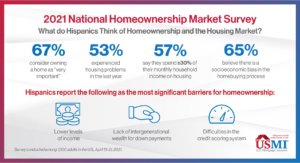Blog: Hispanic Homeownership: How Hispanic Population Growth Helps Drive the Homeownership Market
Hispanic homeownership has grown for six consecutive years, even during the COVID-19 pandemic. Sustainably increasing homeownership access through policy tools such as low down payment lending can help bridge the homeownership gap

September 15 marks the beginning of Hispanic Heritage Month, and it is an opportunity to recognize the significant contributions and influence of Hispanic Americans to the history, culture, and achievements of the United States. It is also a moment to reflect on Hispanic homeownership in America. In particular, over the last few years, the Hispanic population has been a key component of the growth in homeownership in the U.S., and it is projected to be the demographic group leading this segment of the industry for the next four decades.
According to the 2020 U.S. Census Bureau report, over the next 40 years Hispanics will be the primary contributors to the U.S. population growth, accounting for 68 percent between now and 2060. The Urban Institute also projects that from 2020 to 2040, most net new homeowners will be Hispanics – estimating that of the 6.9 million new homeowner households, 70 percent will be Hispanic. These figures speak to the importance of this demographic group to our nation and the impact they will have on mortgage markets and the face of homeownership over the next few decades.
Hispanic population growth is also a significant reason to be focused on the barriers to homeownership for all minorities. Economic barriers and housing supply challenges for this population continue to keep homeownership out of reach for many of these potential homeowners. The income gap between Hispanics and non-Hispanic Whites remains steep, with non-Hispanic White households having a median income 26 percent higher than that of Hispanic households. In 2019, the median Hispanic household income was $56,113 (U.S. Census Bureau). Additionally, according to the National Association of Hispanic Real Estate Professional’s (NAHREP) 2020 State of Hispanic Homeownership Report, Hispanics also tend to have higher debt-to-income (DTI) ratios and lower credit scores, and given the youth in the Hispanic community, first-time homebuyers drive Hispanic homeownership gains. In 2019, 56 percent of Hispanic homeowners indicated that they were living in the first home they had ever owned, as reported by the U.S. Census Bureau’s 2019 American Housing Survey. Therefore, Hispanic homebuyers are an important demographic served by low down payment mortgage products, which benefit first-time and low- to moderate-income homebuyers primarily by bridging the down payment gap.
USMI’s 2021 National Homeownership Market Survey, which polled 1,000 adults in the U.S., including an oversample of Hispanics, found that 67 percent of Hispanics consider owning a home as “very important.” Further, the survey found that 53 percent of Hispanic respondents reported having experienced housing problems during the COVID-19 pandemic, with the primary cited concerns including evictions and falling behind rent or mortgage payments.
Among the obstacles Hispanics face, 66 percent indicated that the lack of affordable homes is the biggest housing-related issue. Additionally, 20 percent said that one of the biggest challenges they face when buying a home is the inability to afford a 20 percent down payment, as monthly housing costs consume a large amount of Hispanics’ income – nearly 60 percent said they spend 30+ percent of their monthly household income on housing. Lastly, 65 percent of Hispanics suggested there is socioeconomic bias in the homebuying process, with the survey finding that lower levels of income, lack of intergenerational wealth for down payments, and difficulties in the credit scoring system are the most significant barriers for increasing minority homeownership in the U.S.
However, while these barriers were cited, 90 percent of Hispanics also conveyed that they felt treated fairly during the mortgage process. Nonetheless, myths and misinformation persist around this demographic. By a nearly 3 to 1 ratio compared to White respondents, Hispanics believe the mortgage approval process is not affordable, and stated that they do not fully understand down payment requirements. In fact, 45 percent mistakenly believe a 20+ percent down payment is required, and another 21 percent report they do not know what amount of a down payment is required. In reality, private mortgage insurance (MI) enables homebuyers to purchase homes with down payments as low as 3 percent.
These figures and projections make very clear that as the Hispanic population rapidly grows and has a significant impact on the housing market, policymakers must not lose sight of addressing both near term market challenges, such as the significant lack of affordable homes for purchase or rent, as well as longer-term systemic issues that unnecessarily increase costs or create barriers for minority and lower income homebuyers. Notably, despite having been acutely impacted by the COVID-19 pandemic, Hispanic Americans are the only demographic group to have increased their homeownership rate for six consecutive years (including 2020) according to NAHREP. Removing barriers to minority homeownership will enable even more Hispanic households to benefit from sustainable homeownership in the decades to come.
Private MI enhances the ability of minority and lower income homebuyers to borrow in an affordable and sustainable way, enabling them to achieve housing stability and build wealth—and realize the American Dream. In 2020, nearly 60 percent of borrowers served by private MI were first-time homebuyers and more than 40 percent were borrowers with incomes below $75,000. In fact, USMI’s national survey found that consumers view MI as an important piece of the homeownership puzzle, leveling the playing field by helping low- to moderate-income and first-time homebuyers access home financing.
As we celebrate Hispanic Heritage Month, we are committed to supporting sound and prudent policies that help expand homeownership.
See here for a Spanish version of this blog post.









